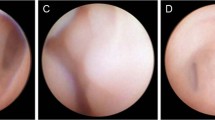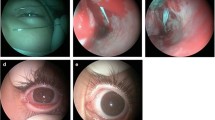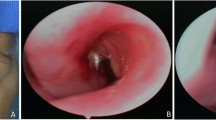Abstract
Purpose
To report our experience with combined use of balloon dacryocystoplasty and monocanalicular intubation with Monoka tubes for treating congenital nasolacrimal duct obstruction.
Design
Retrospective consecutive interventional case series.
Materials and methods
This retrospective study consisted of 25 consecutive pediatric patients with congenital nasolacrimal duct obstruction who underwent balloon dacryocystoplasty and monocanalicular intubation with Monoka tubes between November 2003 and November 2006. Outcome evaluations included an ophthalmologic examination and a dye appearance test postoperatively. Age, history of a prior probing and complications related to the main outcome were also analyzed.
Results
Thirty-three eyes of 25 patients aged 8 months to 9 years (3.5 ± 2.4 years old) were included. Of the obstructed ducts treated, 97% (32/33) showed complete resolution of epiphoria. When analyzed by age groups, patients more than 1 year of age had higher success rate (30 successes in 30 patients) than patients less than 1 year of age (two successes in three patients). Statistical analysis revealed no statistically significant difference in success rate between both age groups (p = 0.09). The mean duration of intubation was 5.7 ± 2.2 months. No significant complication was noted, except that early tube dislodgements occurred in six out of 31 Monoka intubations (19%).
Conclusions
The combined use of balloon dacryocystoplasty and monocanalicular intubation with Monoka tubes is an effective procedure for children with congenital nasolacrimal duct obstruction after failure of conservative treatment or probing.



Similar content being viewed by others
References
Katowitz JA, Welsh MG (1987) Timing of initial probing and irrigation in congenital nasolacrimal duct obstruction. Ophthalmology 94:698–705
Wagner RS (1996) Lacrimal disorders. Ophthalmol Clin North Am 9:229–237
Piest KL, Katowitz JA (1991) Treatment of congenital nasolacrimal duct obstruction. Ophthalmol Clin North Am 4:201–209
Yen KG, Yen MT (2002) Managing the tearing infant Nasolacrimal duct obstruction. Contemp Ophthalmol 1:1–5
Nelson LB, Calhoun JH, Menduke J (1985) Medical management of congenital nasolacrimal duct obstruction. Ophthalmology 92:1187–1190
Robb RM (1985) Treatment of congenital nasolacrimal system obstruction. J Pediatr Ophthal Strabismus 22:36–37
Katowitz JA, Welsh MG (1987) Timing of initial probing and irrigation in congenital nasolacrimal duct obstruction. Ophthalmology 94:698–705
Becker B, Berry FD, Koller H (1996) Balloon catheter dilatation for treatment of congenital nasolacrimal duct obstruction. Am J Ophthalmol 121:304–309
Chen PL, Hsiao CH (2005) Balloon dacryocystoplasty as the primary treatment in older children with congenital nasolacrimal duct obstruction. J AAPOS 9:546–549. doi:10.1016/j.jaapos.2005.08.002
Tien DR, Young D (2005) Balloon dilation of the nasolacrimal duct. J AAPOS 9:465–467. doi:10.1016/j.jaapos.2005.05.004
Dorztbach RK, France TD, Kushner BJ, Gonnering RS (1982) Silicone intubation for obstruction of the nasolacrimal duct in children. Am J Ophthalmol 94:585–590
Kraft SP, Crawford JS (1982) Silicone tube intubation in disorders of the lacrimal system in children. Am J Ophthalmol 94:290–299
Welsh MG, Katowitz JA (1989) Timing of silastic tubing removal after intubation for congenital nasolacrimal duct obstruction. Ophthal Plast Reconstr Surg 5:43–47. doi:10.1097/00002341-198903000-00007
Leone CR Jr, Van Gemert JV (1990) The success rate of silicone intubation in congenital lacrimal obstruction. Ophthalmic Surg 21:90–92
Al-Hussain H, Nasr AM (1993) Silastic intubation in congenital nasolacrimal duct obstruction: A study of 129 eyes. Ophthal Plast Reconstr Surg 9:32–37. doi:10.1097/00002341-199303000-00004
Ratcliff CD, Meyer DR (1994) Silicone intubation without intranasal fixation for treatment of congenital nasolacrimal duct obstruction. Am J Ophthalmol 118:781–785
Fayet B, Bernard JA, Pouliquen Y (1989) Reparation des plaies canaliculaires recentes avec une sonde mono-canaliculaire a fixation meatique. Bull Soc Ophtalmol Fr 89:819–825
Fayet B, Bernard JA (1990) Une sonde mono-canaliculaire à fixation méatique auto-stable dans la chirurgie des voies lacrymales d’excrétion. Ophtalmologie 4:351–357
Long JA (1988) A method of monocanalicular silicone intubation. Ophthalmic Surg 19:204–205
Munk PL, Lin DTC, Morris C (1990) Radiology 177:687–690
Tao S, Meyer DR, Simon JW (2002) Success of balloon catheter dilatation as a primary or secondary procedure for congenital nasolacrimal duct obstruction. Ophthalmology 109:2108–2111. doi:10.1016/S0161-6420(02)01216-2
Lueder GT (2002) Balloon catheter dilation for treatment of older children with nasolacrimal duct obstruction. Arch Ophthalmol 120:1685–1688
Honavar SG, Prakash VE, Rao GN (2000) Outcome of probing for congenital nasolacrimal duct obstruction in older children. Am J Ophthalmol 130:42–48. doi:10.1016/S0002-9394(00)00388-3
Kashkouli MB, Beigi B, Parvaresh MM (2003) Late and very late initial probing for congenital nasolacrimal duct obstruction what is the cause of failure? Br J Ophthalmol 87:1151–1153. doi:10.1136/bjo.87.9.1151
Paul TO, Shepherd R (1994) Congenital nasolacrimal duct obstruction natural history and the timing of optimal intervention. J Pediatr Ophthalmol Strabismus 31:362–367
Kaufman LM, Guay-Bhatia LA (1998) Monocanalicular intubation with Monoka tubes for the treatment of congenital nasolacrimal duct obstruction. Ophthalmology 105:336–341. doi:10.1016/S0161-6420(98)93445-5
Goldstein SM, Goldstein JB, Katowitz JA (2004) Comparison of monocanalicular stenting and balloon dacryoplasty in secondary treatment of congenital nasolacrimal duct obstruction after failed primary probing. Ophthal Plast Reconstr Surg 20:352–357. doi:10.1097/01.IOP.0000134271.25794.96
Pe MR, Langford JD, Linberg JV, Schwartz TL, Sondhi NS (1998) Ritleng intubation system for treatment of congenital nasolacrimal duct obstruction. Arch Ophthalmol 116:387–391
Yagci A, Karci B, Ergezen F (2000) Probing and bicanalicular silicone tube intubation under nasal endoscopy in congenital NLDO. Ophthal Plast Reconstr Surg 16:58–61. doi:10.1097/00002341-200001000-00013
Migliori ME, Putterman AM (1988) Silicone intubation for the treatment of congenital lacrimal duct obstruction successful results removing the tubes after six weeks. Ophthalmology 95:792–795
Lim CS, Martin F (2004) Nasolacrimal duct obstruction in children: Outcome of intubation. J AAPOS 8:466–472. doi:10.1016/j.jaapos.2004.06.013
Funding/support
None.
Financial disclosures
None.
Contributions of authors
Design and conduct of the study (Yu Hsun Huang, Shu Lang Liao); collection, management, analysis, and interpretation of the data (Yu Hsun Huang, Shu Lang Liao); and preparation, review, or approval of the manuscript (Yu Hsun Huang, Shu Lang Liao, Luke L-K Lin).
Statement about conformity with author information
Local administrative and ethical committees approved all aspects of this study, and consent was obtained from each patient or family members/guardians of those enrolled in the study.
Author information
Authors and Affiliations
Corresponding author
Rights and permissions
About this article
Cite this article
Huang, Y.H., Liao, S.L. & Lin, L.LK. Balloon dacryocystoplasty and monocanalicular intubation with Monoka tubes in the treatment of congenital nasolacrimal duct obstruction. Graefes Arch Clin Exp Ophthalmol 247, 795–799 (2009). https://doi.org/10.1007/s00417-009-1071-0
Received:
Revised:
Accepted:
Published:
Issue Date:
DOI: https://doi.org/10.1007/s00417-009-1071-0




